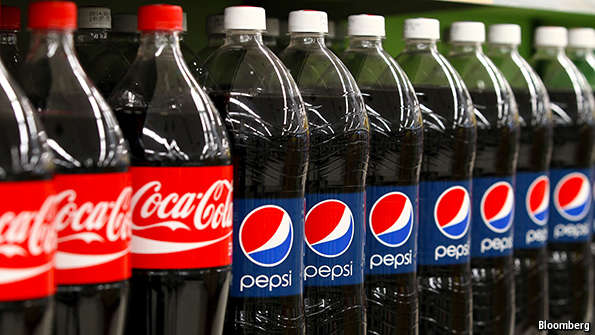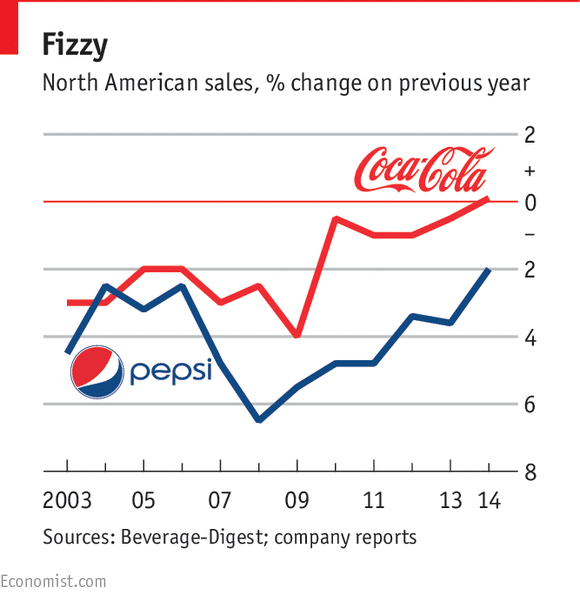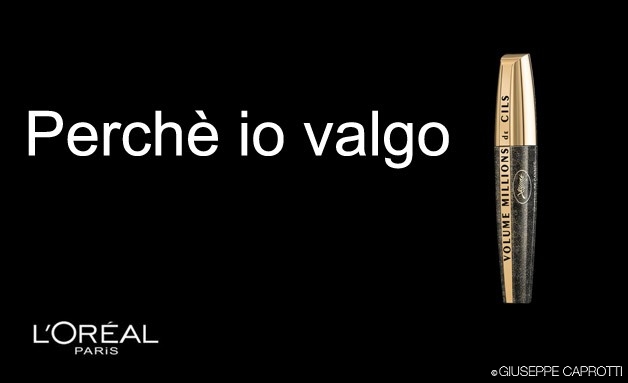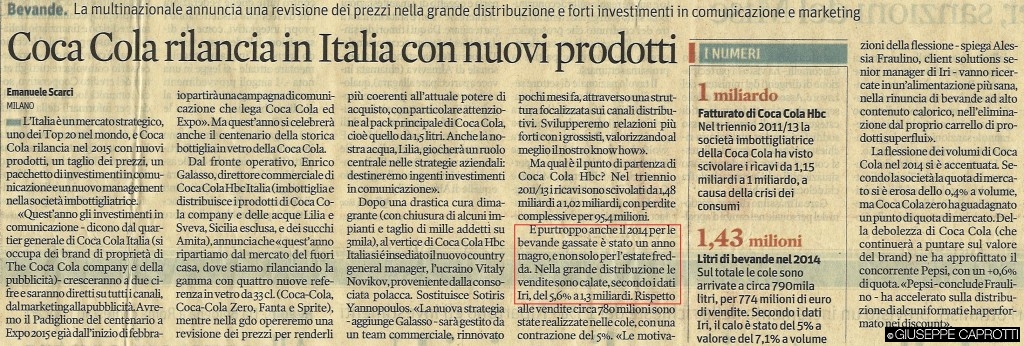A ottobre del 2014 Coca- Cola aveva annunciato un piano strategico con tagli di costi per 3 miliardi in tre anni.
A dicembre dello stesso anno ha confermato il suo stato di crisi, con la possibilità di 2000 licenziamenti a livello globale , su un organico totale di 130’600 persone.
l’8 gennaio 2015, Coca- Cola ha confermato il piano strategico che porterà al licenziamento di un numero di dipendenti che oscillerebbe tra i 1600 e i 1800.
N.B.:
a) già nel 2000 Coca- Cola aveva licenziato 5’000 persone.
b) il titolo di Le Figaro sopra accenna a 1600 lavoratori. Nel testo dell’articolo, invece, questi toccherebbero le 1800 unità.
I problemi della multinazionale di Atlanta sono due:
1) le spese generali troppo alte, che incidono per più del 40% sul suo fatturato (abbiamo visto in Esselunga contro Coca-Cola come Coca- Cola possa a volte “eccedere” nelle pubbliche relazioni… ), con un’organizzazione troppo gerarchizzata ed inefficiente.
2) ma la ragione principale risiede nella forte disaffezione, da parte dei consumatori occidentali, per le bevande gassate, ormai associate a obesità e junk food (cibo spazzatura).
I consumatori, inoltre, diffidano degli dolcificanti contenuti nella famosa bevanda a stelle e strisce.
Il fatturato, poco brillante in Italia (v. Come stanno andando le grandi marche e la GD), ha segnato un – 0,4% a livello mondo nel terzo trimestre del 2014.
I segnali sono stati pessimi negli USA e in America Latina che hanno espresso rispettivamente un -2% e un -4% .
Si tratta di due continenti che ormai lottano contro l’obesità da tanti anni (v. in proposito anche “A scuola di cibo”).
Questi risultati non sono stati compensati dall’Africa e dal Medio Oriente (+5% e + 6%) e dalla diversificazione effettuata nel tempo, con l’acquisizione di aziende o divisioni producenti bevande non gasate, come Minute Maid o acqua (es.: la Lilia in Italia).
Ci sembra importante segnalare che il principale quotidiano economico e finanziario del nostro paese, Il Sole 24 ore, controllato da Confindustria, si sia ben guardato dal riferire le notizie riguardanti la multinazionale di Atlanta.
Ciò era già successo in altri casi, vedi, ad esempio, il caso della Multa di 1 miliardo di € al “Cartello dello shampoo”.
p.s.: nessun accenno ai tagli a livello globale su questo articolo del 16 gennaio ma una conferma sul calo molto forte dei consumi delle cole in Italia (- 5,6% nel 2014, a valore).
mentre le notizie, a livello globale, non migliorano:
sia Coca -Cola che Pepsi hanno visto peggiorare la loro situazione con il rafforzamento del dollaro, sia sul fronte dei ricavi che su quello dei costi delle materie prime, comprate prevalentemente in $…
Soft-drinks makers
Flat or fizzy?
Coca-Cola and PepsiCo are being hit by the strong dollar

FIZZY drinks are known by scientists to be unhealthy. They contribute to obesity, encourage tooth decay and are full of sugar. And now, some analysts add that they are bad for your wealth too, if you happen to own a company that makes them. On February 10th, Coca-Cola announced that its profits fell by 55% in the fourth quarter of 2014. The next day, PepsiCo, Coke’s rival, revealed that it performed only slightly better, with profits dropping by a quarter.
I profitti di Coca-Cola sono scesi del 55% mentre Pepsi ha annunciato che i suoi sono scivolati “solo” del 25%…
Ma sul lato vendite negli USA, The Economist.com – sotto- stigmatizza come Pepsi abbia avuto delle performances più basse delle multinazionale di Atlanta.

Many commentators point to falling sales of fizzy drinks in North America for Coca-Cola and PepsiCo’s woes, as consumers become more interested in healthy eating and drinking. Indeed, sales of their flagship brands of cola have steadily fallen over the last decade (see chart). But this alone cannot explain their current problems. Sales of Coke in terms of volume started to rise last year, with revenues from fizzy drinks now growing at both firms due to the increased popularity of smaller (and higher priced) cans.
Like many other American multinationals, Coca-Cola and PepsiCo are both being hit by the strong dollar. Coke makes 75% of its revenues outside the United States and PepsiCo 42%, but these sales are now worth less in dollar terms due to other currencies weakening against the greenback. At the same time, many of their costs are rising with the dollar, producing a squeeze on profits. That goes some way to explain why PepsiCo is doing so badly, albeit less so than Coke, and in spite of its investments in healthier products such as Tropicana orange juice and Quaker Oats breakfast cereals.
But putting aside their currency-related woes and the shrinking market for carbonated drinks, many investors still see the two firms as smart investments. Warren Buffett, for instance, has called sugar-based manufacturers a “dream business” to be in—for their ability to sell addictive products without fear of regulation or taxation on the scale faced by the alcohol and tobacco industries. No wonder that Mr Buffett’s investment firm, Berkshire Hathaway, still owns around 9% of Coca-Cola’s shares in spite of the firm’s current problems. Although it is a long-term bet, it is one which may well leave him with a sweet taste in his mouth.








